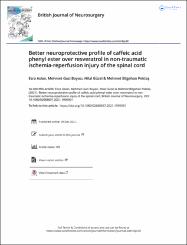Better neuroprotective profile of caffeic acid phenyl ester over resveratrol in non-traumatic ischemia-reperfusion injury of the spinal cord

Göster/
Erişim
info:eu-repo/semantics/embargoedAccessTarih
09.12.2021Üst veri
Tüm öğe kaydını gösterKünye
Aslan, E., Boyacı, M. G., Güzel, H., & Pektaş, M. B. (2021). Better neuroprotective profile of caffeic acid phenyl ester over resveratrol in non-traumatic ischemia-reperfusion injury of the spinal cord. British Journal of Neurosurgery, 1-7.Özet
Background
Spinal cord ischemia has serious sequelae. The aim of this study is to investigate the effects of resveratrol and caffeic acid phenyl ester (CAPE), a propolis derivative, on spinal cord injury induced by ischemia-reperfusion (IR).
Methods
In our research, 30 male Wistar albino rats, 200–250 gr, were used. Before the experiment, during a week of the process, the rats were fed with these two agents, and the experimental group rats were exposed to spinal cord IR injury. At the end of the experiment, spinal cord samples were taken from the sacrificed rats. Bax, p53, nNOS, and Beclin-1 immunoreactivity moreover TUNEL (+) cells were evaluated with immunohistochemically in the IR-induced damaged rats.
Results
It has been clearly determined that the TUNEL (+) apoptotic cell number and immunopositive cells of nNOS, Beclin-1, p53, Bax were raised in the IR group. However, these increments partially were restored in the resveratrol and CAPE-fed rats with IR-induced injury.
Conclusion
In light of our data, resveratrol, and CAPE could be beneficial in spinal cord IR injury. Although both agents provide beneficial effects, it can be said that CAPE is partially more effective in spinal cord injury caused by IR.















